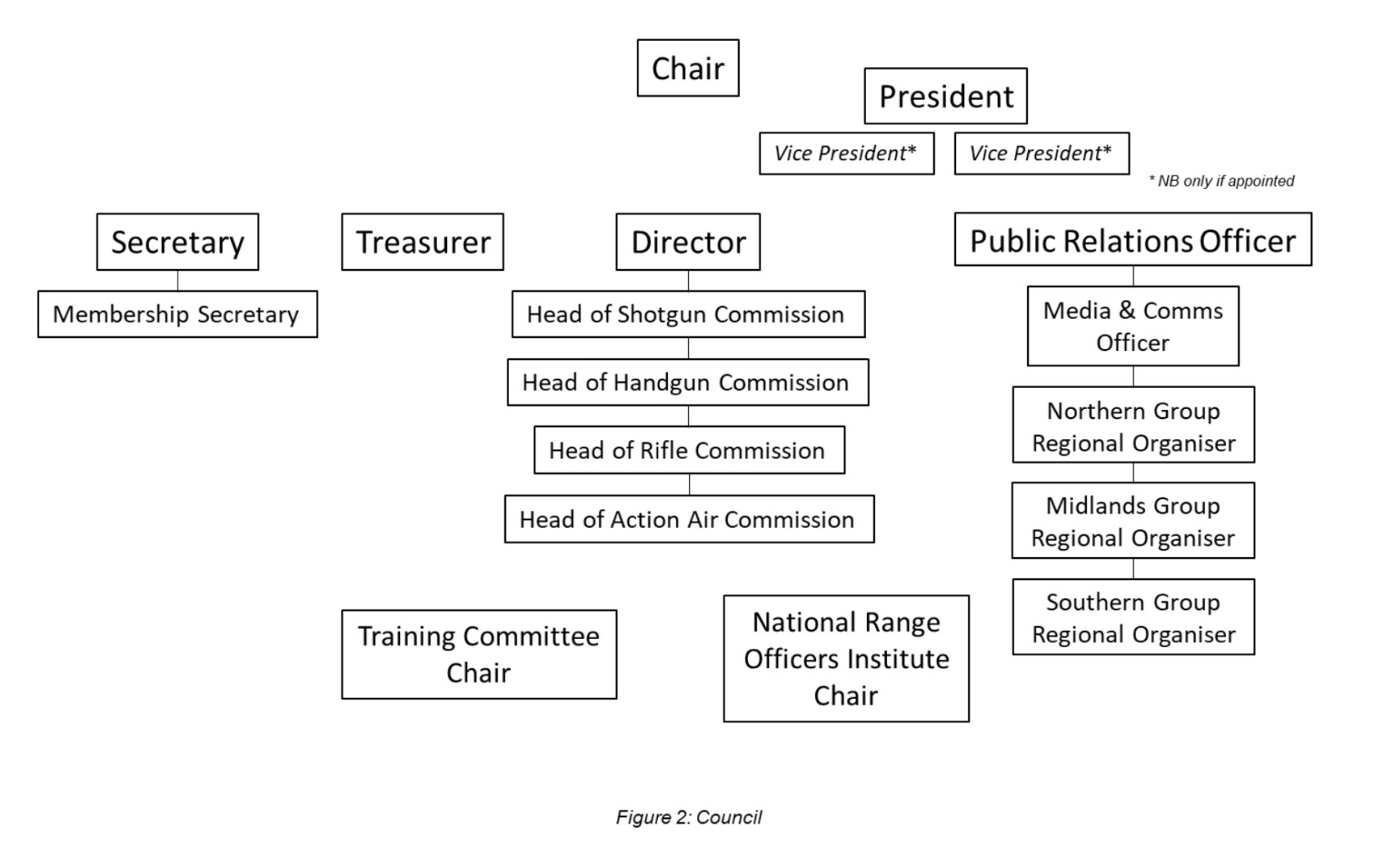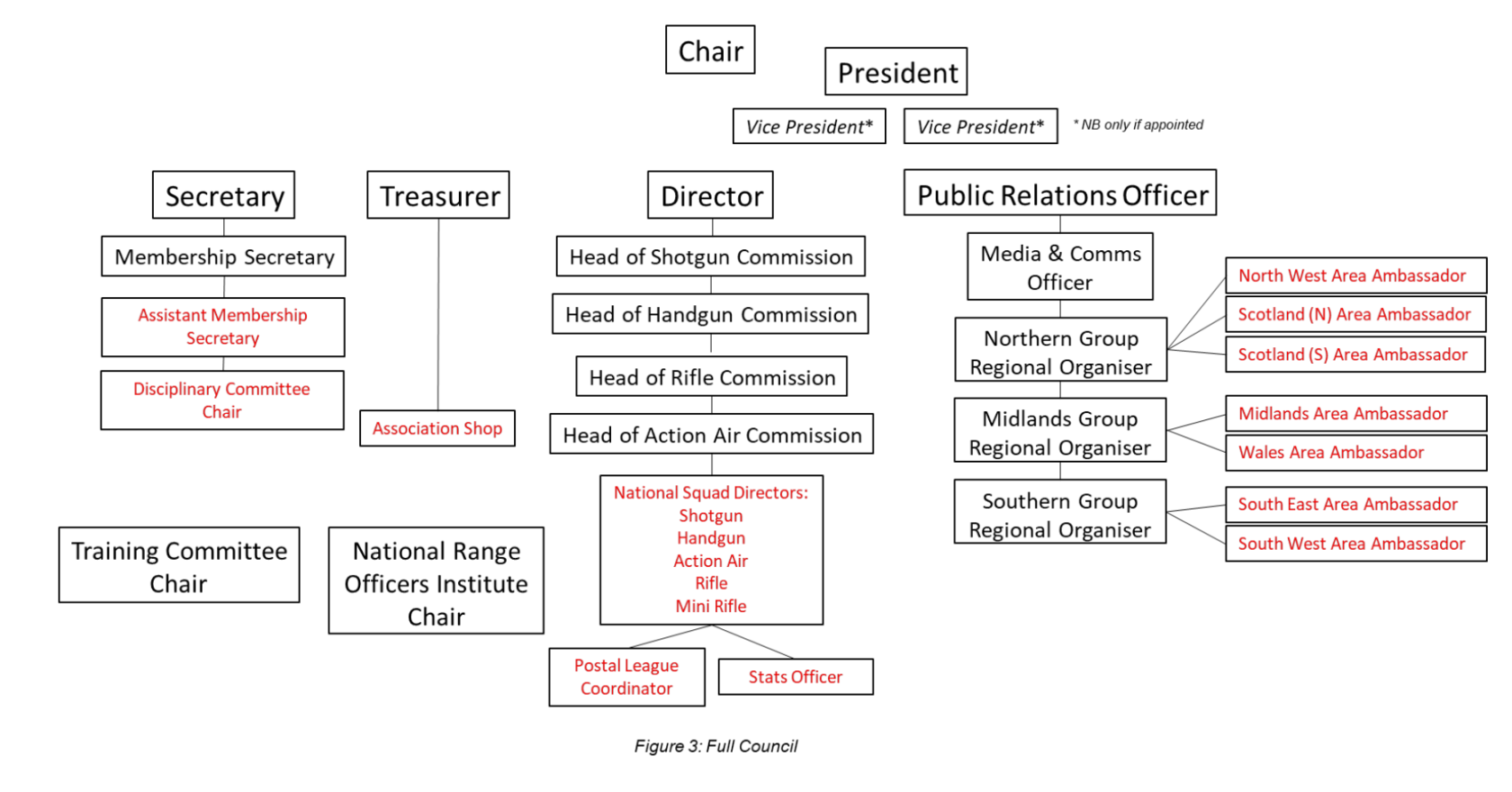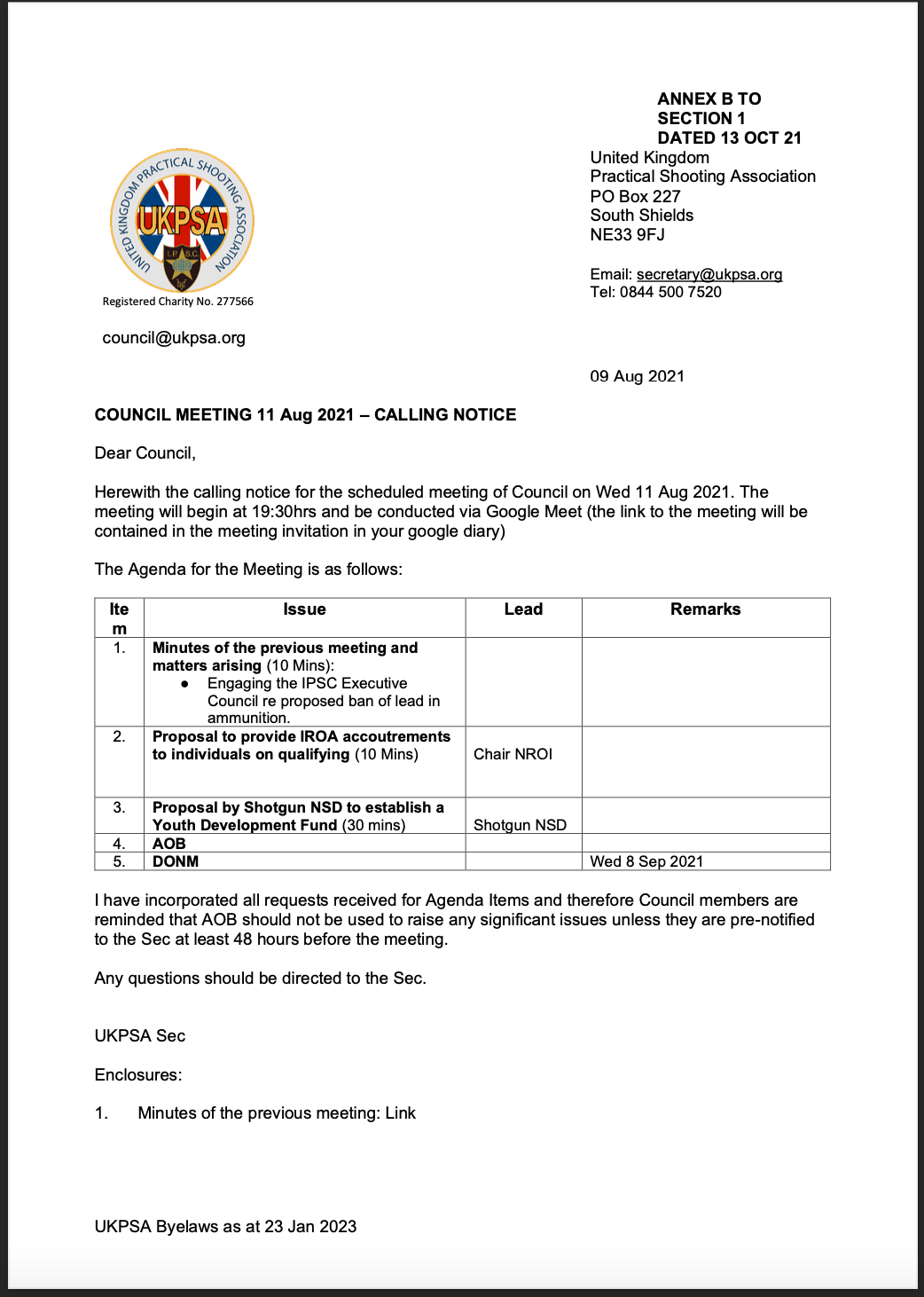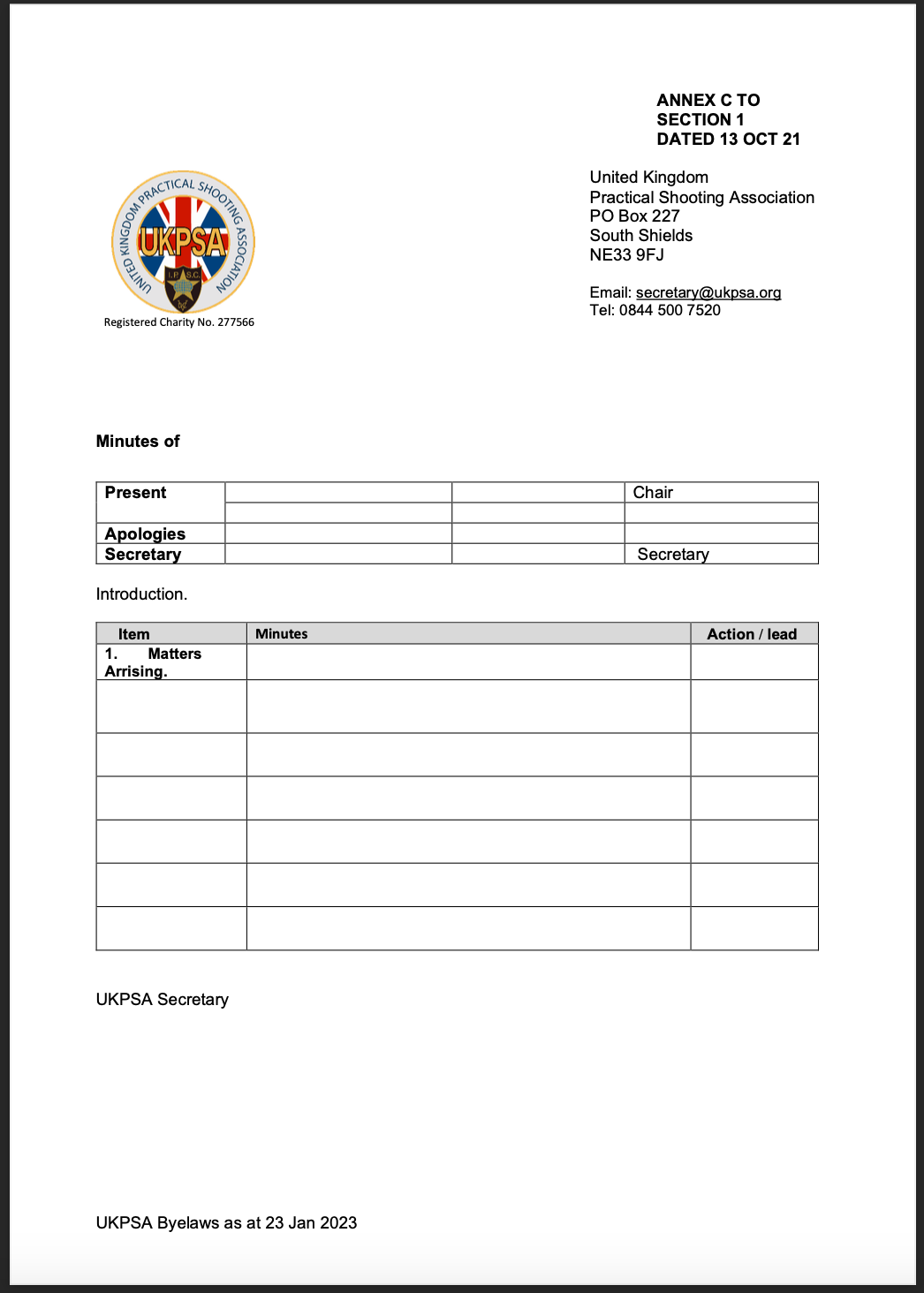Section 1 - Structure and Operation of Council
- Council Structure. In accordance with Article XI of the Associations’ Constitution, the
management of the Association shall be controlled by a council which consists of members elected by the membership at the AGM, and further augmented by members appointed to additional roles by those elected officers. There are 3 elements to the Associations managing council; the Executive Council, Council and Full Council.- Executive Council. Members of the Association shall be elected at the AGM, by those present and entitled to vote, to the roles of Chair, Director (also known as the Regional Director or RD), Secretary, Treasurer and Public Relations Officer. These elected officers shall assume their appointments at the conclusion of business of the AGM at which they have been elected. Within 14 days after election at the AGM, the elected officers shall appoint a member of the Association to serve in the role of President of the Association. They may also consider the appointment of not more than two Vice Presidents should they deem it appropriate to do so. Collectively, the Elected Officers, the appointed President (and any Vice Presidents) shall be known as the Executive Council as illustrated at Figure 1 below. They shall be entitled to exercise a single vote upon any resolution, save the Chair who shall not be entitled to vote upon any resolution unless the outcome of such a vote is a tie whereupon they shall be able to cast a deciding vote.
- Council. Within 14 days after election at the AGM, the Elected Officers shall appoint a member of the Association to serve in one or more of the roles illustrated at Figure 2. Each member appointed to one of these roles shall be entitled to exercise a single vote upon any resolution, save the Chair who shall not be entitled to vote upon any resolution unless the outcome of such a vote is a tie whereupon they shall be able to cast a deciding vote. For the avoidance of doubt, no individual shall be entitled to cast more than a single vote upon any resolution by dint of them holding more than 1 role shown in Figure 2. Collectively the structure illustrated below at Figure 2 shall be known as Council.
- Full Council. Within 14 days after election at the AGM, the Elected Officers shall
appoint a member of the Association to serve in one or more of the additional roles illustrated at Figure 3 shown in red text. Members appointed to these important roles shall not however be entitled to vote if they are required to attend meetings of Council.
- Head of Group Responsibility. As illustrated at Figure 3 above, the Secretary,
Treasurer, Director and Public Relations Officer shall act as the functional lead for all members of Full Council within their ‘stack’. In addition to providing routine direction to those members of Council within their portfolio, they should also coordinate the attendance at meetings of Council by non-voting members of Full Council as required to support the agenda at hand. - Procedure for the Selection and Appointment of Members to Full Council roles. Not less than 30 days prior to the date of the AGM, the Secretary should publish the current structure of Full Council, the current incumbents and invite the membership to volunteer to fill these roles in the coming year. The published structure should indicate the names of those incumbents who either intend to step down, or are willing to continue to serve the Association for another year. All elected officers shall be deemed to have resigned at the conclusion of business of the AGM unless they are re-elected to such a role during the AGM. All appointed
or co-opted members of Full Council shall be deemed to have resigned on the 14th day after the Associations’ AGM1.- Any candidates wishing to stand for election at the AGM to a role on the Executive Council should usually inform the Secretary no later than 30 days prior to the AGM2.
- Any prospective candidate must be proposed and seconded by members of the Association entitled to vote at an AGM.
- Any proposed candidate must have been a member of the Association ‘in good standing’ for a minimum of 5 years prior to the AGM at which they are seeking election.
- When there are at least two or more prospective candidates for an elected role who have been notified to the Secretary ahead of the AGM, nominations from the floor at the AGM will not be considered. If there is only a single candidate, or less, that have been notified to the Secretary ahead of the AGM, then the Chair will invite nominations from the floor. At the time of the AGM, should there be less than 2 candidates standing for a role then the Chair shall invite nominations from the floor.
- Any volunteers to fill roles on Full Council should notify the Secretary no later than the close of the AGM.
- The elected officers shall make an offer to members who volunteer to fill roles on Full Council in writing. The Role Description for the post should be included in the letter of Offer.
- Members offered a role on Full Council shall confirm in writing that they accept the appointment and understand the scope of the post they have been offered.
- All appointments shall be formally notified to the membership in writing within 14 days after the AGM. Such appointments will come into force on the 15th day following the AGM.
- Any candidates wishing to stand for election at the AGM to a role on the Executive Council should usually inform the Secretary no later than 30 days prior to the AGM2.
- Duties of Council members. Some of the duties of the following roles are described in the UKPSA Constitution: Chair, Director, Secretary, Treasurer, Public Relations Officer and Regional Organisers. Full Role Descriptions for each position within Full Council are attached at Annex A to Section 1 of these byelaws. For the avoidance of doubt, the Elected Officers have no additional powers vested in them other than their responsibility to appoint individuals to Council or Full Council roles within 14 days of their election at the AGM or to meet specific requirements under their obligations as Trustees as defined by the Charities Commission for England and Wales. For the avoidance of doubt, the Executive Council have no other powers vested in them unless conferred by resolution of Council.
- Executive Council. Members of the Association shall be elected at the AGM, by those present and entitled to vote, to the roles of Chair, Director (also known as the Regional Director or RD), Secretary, Treasurer and Public Relations Officer. These elected officers shall assume their appointments at the conclusion of business of the AGM at which they have been elected. Within 14 days after election at the AGM, the elected officers shall appoint a member of the Association to serve in the role of President of the Association. They may also consider the appointment of not more than two Vice Presidents should they deem it appropriate to do so. Collectively, the Elected Officers, the appointed President (and any Vice Presidents) shall be known as the Executive Council as illustrated at Figure 1 below. They shall be entitled to exercise a single vote upon any resolution, save the Chair who shall not be entitled to vote upon any resolution unless the outcome of such a vote is a tie whereupon they shall be able to cast a deciding vote.
- Operation of Council members. In accordance with the Constitution, all decisions which affect the Association shall be made as a collective group3. No member of Full Council has the authority to act against, overrule or ignore the wishes of the council. They are responsible for ensuring that all decisions are taken in the best interests of the Association.
- Method of communicating with members. The Association needs to communicate with its members on various matters (e.g. membership renewal, competition calendar, notices for General Meetings, DVC Magazine, etc). Email is the preferred method of communicating with members, supported by use of the Association’s web site and social media outlets. Communications will be sent by email as long as the member has supplied a working email address to the Association and has not indicated that they are unwilling to receive communications by email.
- Members who have supplied a working email address to the Association but have indicated they are unwilling to receive communications by email, together with those members who have not supplied a working email address, will receive communications by post.
-
Meetings of Council. In accordance with the Constitution, Council shall meet on no less than 4 occasions throughout the year. Given the availability of reliable video-teleconferencing facilities and experience to date, Council will routinely meet virtually as required however, Council shall also hold face to face meetings on not less than 2 occasions during the year unless there are compelling reasons not to do so.
- Notification. The Secretary should issue notice of a meeting at least 14 days in advance by email. This notification shall be followed by a formal calling notice for each council meeting which includes the confirmed agenda for the meeting. An exemplar of the calling notice is attached at Annex B to this section.
- Agenda. Any items of business for the agenda for each scheduled meeting
should be sent to the Secretary no later than 10 days prior to the meeting. Any items arising after this should be notified to the Secretary at least 48 hours prior to the meeting and included in the AoB item of the agenda if appropriate. AoB shall not be used to discuss items of significance unless there are extenuating circumstances to do so.- Reporting against Strategic Objectives. Members of Council with
responsibility for the Associations Strategic Objectives should provide a report to Council at least quarterly regarding the measures of performance against them. They should also prepare an annual report as at December for inclusion in the reports to the Membership at the AGM.
- Reporting against Strategic Objectives. Members of Council with
- Attendance. Attendance of meetings shall be as follows:
- All members of Council filling roles shown at Figure 2 above should routinely attend meetings.
- When a voting member gives their apologies for a meeting, their vote may be transferred to a deputy (who must be a member of Full Council as shown in Figure 3 above) with prior notice to the secretary.
- Members of Full Council (ie those not holding a position on the Executive Council or Council in accordance with Figure 1 or Figure 2 above) will usually only attend meetings when specifically invited to do so by their Head of Group in order to address specific agenda items within their purview.
- Any member of the Association may attend meetings as an observer in accordance with the Constitution. In order to attend a meeting as an observer, a request should be made to the Secretary in writing at least 7 days before the scheduled meeting.
- Quorum. No business shall be transacted unless there is a Quorum. Whilst the Constitution defines Quorum as there being 5 members present for meetings of Council; business will not usually be conducted with fewer than two thirds of Council present including the Chair4. The Chair of the meeting shall not be entitled to vote upon any resolution unless the outcome of such a vote is a tie whereupon they shall be able to cast a deciding vote.
- Conduct of Meetings. The Chair shall control meetings and ensure that business is conducted in an orderly and efficient manner. The Chair shall be assisted in doing so by the Secretary (in particular whilst making use of video teleconferencing facilities). All decisions affecting the Association shall be made by way of voting on motions proposed by Council members unless Council has previously delegated authority to individuals or other committees to act unilaterally.
- All meetings shall be suitably chaired. In the event that the elected Chair is unavailable to attend a meeting of Council then the following shall act as chair of the meeting in order of precedence:
- Treasurer
- Secretary
- Director
- PRO.
- President
- Vice President (if appointed)
- Any member of Council who is nominated, seconded and approved by a majority vote by those present at the meeting and entitled to vote.
- A motion must be Proposed and Seconded in order for a vote to be called.
- A simple majority of votes cast is required for a motion to pass unless the Constitution specifies a margin needed for a certain motion to be carried. In which case the Constitution takes precedence (e.g. Article VII requires a 2/3 majority for a motion to amend the UKPSA Constitution to be carried).
- All meetings shall be suitably chaired. In the event that the elected Chair is unavailable to attend a meeting of Council then the following shall act as chair of the meeting in order of precedence:
- Recording. The Secretary shall be responsible for ensuring an accurate record of the meeting is made. Minutes of the meeting should be drafted and approved by Council at the following meeting before they are then published to the Associations records system. An exemplar of how the minutes of a meeting should be recorded are at Annex C to this section.
- Acceptance of Minutes. The minutes of a meeting shall be considered to be in Draft until they have formally been accepted as an accurate record of the business conducted at that meeting by Council. The first item of business at any meeting shall be the proposal to Council that the minutes of the previous meeting are accepted.
- Publication of Minutes. Once minutes have been accepted by Council, they should be published to a suitable online location which is accessible to the membership.
- Method of communicating with members. The Association needs to communicate with its members on various matters (e.g. membership renewal, competition calendar, notices for General Meetings, DVC Magazine, etc). Email is the preferred method of communicating with members, supported by use of the Association’s web site and social media outlets. Communications will be sent by email as long as the member has supplied a working email address to the Association and has not indicated that they are unwilling to receive communications by email.
1 Appointees shall continue to serve in their role up to the 14th day after the AGM in order to ensure that routine business such as the processing of membership applications, match sanctioning etc may continue without interruption.
2 This is in order to ensure that the membership are informed in good time ahead of the AGM.
3 The appointment of members to roles within the Full Council structure which are made no later than 14 days after the AGM by the officers elected at that meeting are considered to have been made as a collective group.
4 (Empty)







No Comments